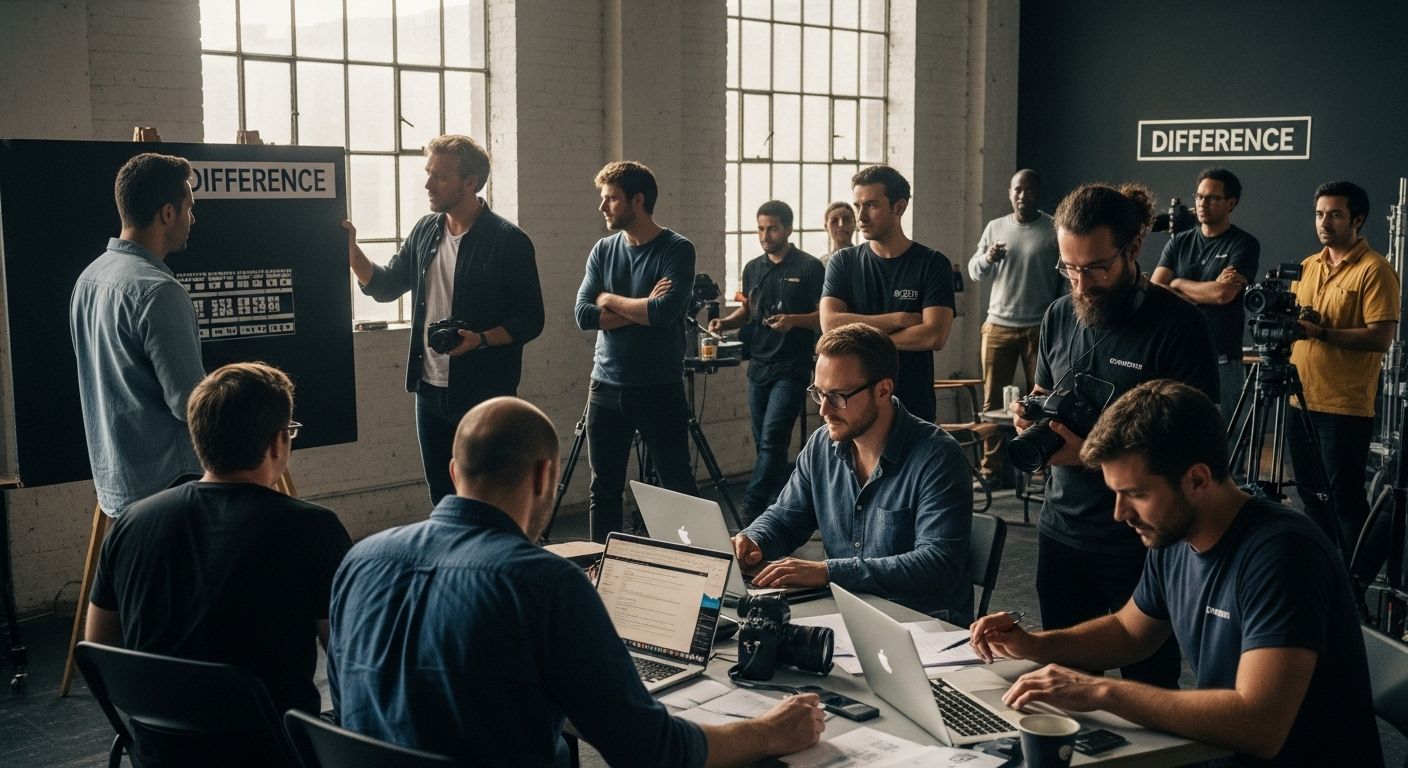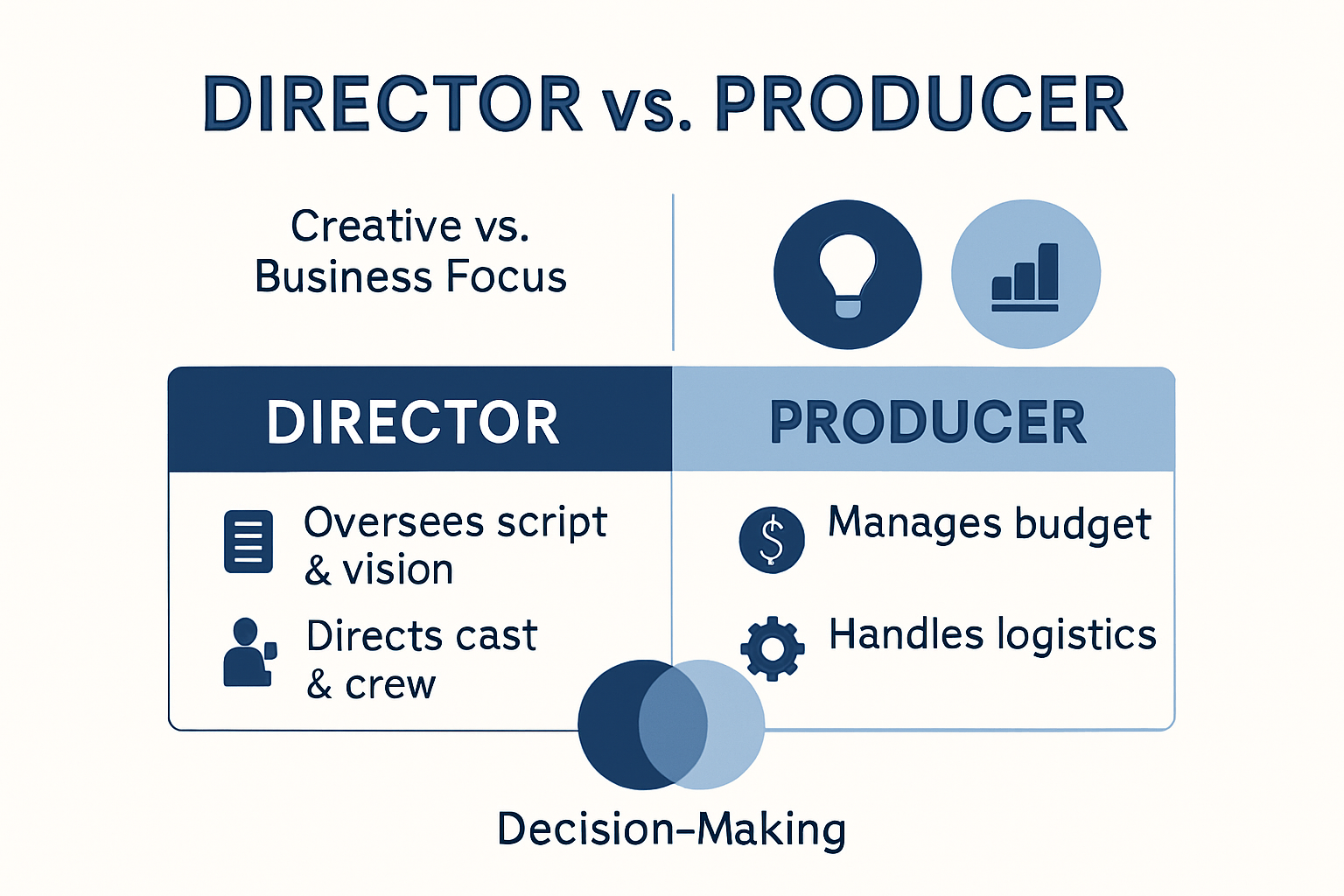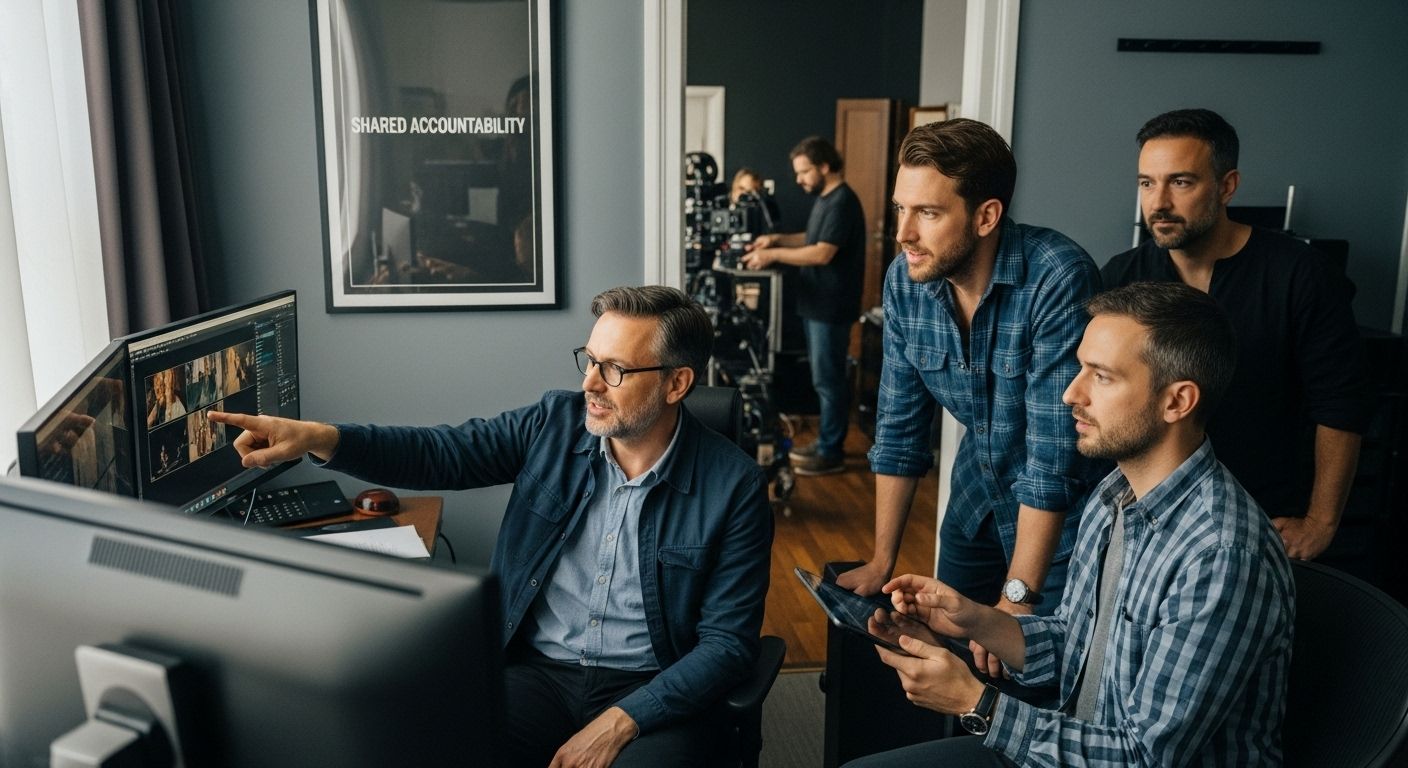Understanding the Difference Between Director and Producer
- info1419758
- Aug 22
- 8 min read
Every film you love started with a director’s unique vision and a producer’s watchful eye over the budget. But even though the director gets most of the glory, producers negotiate contracts, secure funding, and control every dollar spent. The real surprise? Film projects live or die not just by creative talent but by the intense teamwork and constant negotiation between these two roles.

Table of Contents
Quick Summary
Takeaway | Explanation |
Directors shape the creative vision. | Directors transform scripts into visual stories through artistic decisions and direction of performances and visuals. |
Producers manage financial and logistical elements. | Producers oversee budgets, contracts, and resource allocation, ensuring projects are feasible and well-organized. |
Collaboration is key for success. | Directors and producers must communicate effectively to align artistic goals with financial realities, fostering project cohesion. |
Balance creativity with practicality. | Successful projects require directors to maintain artistic integrity while producers ensure all aspects are logistically viable. |
Shared accountability leads to memorable productions. | Both roles are interdependent, working together to create films that engage audiences while being financially sustainable. |
Key Roles of a Director in Film Production
Directors are the creative visionaries who transform scripts into compelling visual narratives, serving as the primary artistic force guiding every aspect of a film’s production. Learn more about film production strategies to understand the intricate process.
Creative Leadership and Vision
In film production, directors hold the crucial responsibility of translating written scripts into vivid cinematic experiences. According to the U.S. Bureau of Labor Statistics, their primary duties encompass making critical creative decisions that shape the entire production. This includes:
Selecting and directing cast members
Conducting rehearsals and guiding performance nuances
Collaborating with set designers and art directors
Working closely with costume designers to maintain visual coherence
A director’s vision extends beyond mere technical execution. They must possess an intricate understanding of storytelling, visual composition, and emotional depth to effectively communicate the narrative’s core themes.
Technical and Collaborative Responsibilities
Beyond creative direction, directors manage complex technical and interpersonal dynamics. They work intimately with various production departments to ensure seamless execution of their artistic vision. Key technical responsibilities include:
Reviewing and potentially modifying scripts
Monitoring production budgets
Overseeing all production aspects on and off set
Collaborating with sound and music departments
Guiding film editors during postproduction
Successful directors demonstrate exceptional leadership, combining artistic sensitivity with practical management skills. They must balance creative intuition with logistical constraints, making swift decisions that maintain the project’s artistic integrity while respecting budgetary and time limitations.
Directors are essentially the storytellers who breathe life into written narratives, transforming abstract concepts into powerful visual experiences that resonate with audiences worldwide.
The Essential Functions of a Producer
Producers serve as the critical backbone of film and video production, managing the complex business and logistical aspects that transform creative visions into tangible projects. Learn more about sustainable production strategies to understand their comprehensive role.
Financial and Resource Management
At the core of a producer’s responsibilities is financial stewardship. According to Entertainment Industry experts, producers are responsible for:
Developing and managing production budgets
Securing funding and investment for projects
Negotiating contracts with talent and crew
Controlling overall production expenses
Making critical financial decisions that impact project feasibility
Their financial acumen ensures that creative projects remain economically viable, balancing artistic ambitions with fiscal constraints. Producers must consistently forecast potential financial risks and develop strategic mitigation plans.
Project Coordination and Strategic Planning
Beyond financial management, producers act as central coordinators who orchestrate complex production ecosystems. Their strategic planning involves:
Assembling production teams
Selecting and hiring key creative personnel
Developing comprehensive production schedules
Managing legal and regulatory compliance
Facilitating communication between different production departments
Producers function as crucial intermediaries between creative teams, financial stakeholders, and technical crews. They translate abstract creative concepts into actionable production strategies, ensuring smooth operational workflows.
Business Development and Industry Networking
Successful producers excel in business development, leveraging extensive industry networks to create opportunities. They identify potential projects, negotiate distribution rights, and build relationships that can support current and future productions. Their role extends beyond a single project, positioning them as strategic architects who shape the broader landscape of media production.
Comparing Responsibilities: Director vs. Producer
While directors and producers collaborate closely in film production, their roles are distinctly different, each critical to a project’s success. Learn more about video production planning to understand their complementary functions.
Creative vs. Business Domains
According to California State University, Northridge, the fundamental difference lies in their primary responsibilities. Directors focus on the creative vision, while producers manage the business infrastructure. This division of labor ensures that artistic goals are balanced with practical considerations.
Directors concentrate on:
Artistic storytelling
Performance direction
Visual narrative development
Interpreting and executing script vision
Producers prioritize:
Financial management
Resource allocation
Project feasibility
Logistical coordination
Their roles are symbiotic, with each professional bringing specialized expertise to transform a concept into a finished production.
To better illustrate the differences and complementary nature of these core film production roles, the table below compares the main responsibilities and focus areas of directors versus producers.
Aspect | Director | Producer |
Primary Focus | Creative/artistic vision | Financial, logistical, and business aspects |
Key Responsibilities | Storytelling, casting, performance, visuals | Budgeting, scheduling, contracts, resourcing |
Decision-Making Domain | Creative choices (performance, visuals) | Business/strategic choices (finances, hiring) |
Collaboration | Works with creative and technical teams | Connects creative, financial, and logistical teams |
Outcome Accountability | Artistic quality and narrative integrity | Project feasibility and on-time/on-budget delivery |
Decision Making and Workflow Management
In the production ecosystem, directors and producers have distinct decision making spheres. Directors make creative choices about performance, cinematography, and narrative interpretation. Producers, conversely, make strategic decisions about budget, scheduling, and overall project viability.
Key Workflow Interactions:
Producers select and hire directors
Directors propose creative approaches
Producers approve or adjust based on financial constraints
Directors execute approved creative strategies
This collaborative dynamic requires mutual respect and clear communication to achieve the project’s artistic and commercial objectives.
Professional Interdependence
Ultimately, directors and producers are interdependent professionals whose success depends on understanding and supporting each other’s roles. While their responsibilities differ, their shared goal remains creating compelling, financially viable storytelling experiences that resonate with audiences.
Their partnership represents a delicate balance between artistic imagination and practical execution, transforming creative concepts into tangible, memorable productions.

How Directors and Producers Collaborate
The collaboration between directors and producers represents a sophisticated dance of creative vision and practical execution. Learn more about production planning strategies to understand their intricate relationship.
Communication and Strategic Alignment
According to MIT Gilbert & Sullivan Players’ Production Manual, successful collaboration hinges on consistent and transparent communication. Directors and producers must develop a shared understanding of the project’s core objectives, ensuring that artistic ambitions align with financial and logistical realities.
Key Communication Strategies:
Regular production meetings
Detailed project briefings
Collaborative problem solving
Mutual respect for each other’s expertise
Clear documentation of creative and financial decisions
These communication protocols help bridge the gap between creative imagination and practical implementation, creating a unified approach to storytelling.
Creative Problem Solving and Compromise
Collaboration often requires dynamic negotiation between artistic vision and practical constraints. Directors bring creative concepts, while producers evaluate their feasibility and potential impact. This interaction involves:
Balancing artistic integrity with budget limitations
Finding innovative solutions to production challenges
Adapting creative approaches based on resource availability
Maintaining the project’s core narrative while ensuring financial viability
Successful collaborations emerge from a willingness to understand and accommodate each other’s perspectives, transforming potential conflicts into opportunities for creative innovation.
Shared Accountability and Project Success
Ultimately, directors and producers share a fundamental goal: creating a compelling, memorable production. Their collaboration transcends individual roles, representing a holistic approach to storytelling that combines artistic passion with strategic execution.
By maintaining open communication, mutual respect, and a commitment to the project’s overarching vision, directors and producers can navigate complex production landscapes and bring extraordinary stories to life.

The following table summarizes the main types of collaboration and interaction between directors and producers during a film project, offering a clear at-a-glance reference for understanding their team dynamics.
Collaboration Area | Typical Activities | Shared Goal |
Communication | Production meetings, briefings, documenting decisions | Align vision & logistics |
Problem Solving & Compromise | Balancing budget constraints with artistic vision | Creative solutions within resources |
Accountability | Joint project oversight and risk management | Project success and cohesion |
Impact of Director and Producer Roles on Film Success
The success of a film hinges on the synergistic relationship between directors and producers, each playing a critical role in transforming creative concepts into compelling cinematic experiences. Learn more about sustainable production practices to understand their profound impact.
Creative and Financial Foundations
According to the U.S. Bureau of Labor Statistics, the intricate balance between creative vision and financial feasibility determines a project’s potential success. Directors and producers must work in concert to ensure that artistic ambitions align with economic realities.
Critical Success Factors:
Alignment of creative vision with market expectations
Efficient resource allocation
Compelling storytelling
Strategic financial planning
Innovative problem solving
This collaborative approach transforms raw potential into marketable, engaging content that resonates with audiences and generates commercial success.
Risk Management and Strategic Decision Making
Producers and directors serve as risk mitigators, making strategic decisions that can make or break a film’s trajectory. Their collaborative decision making involves:
Anticipating potential production challenges
Balancing artistic integrity with commercial viability
Adapting creative approaches to budget constraints
Identifying and leveraging unique storytelling opportunities
Maintaining project momentum through proactive management
Successful films emerge from a delicate negotiation between creative aspirations and practical limitations, requiring nuanced understanding and mutual respect.
Long Term Industry Impact
Beyond individual project success, the collaborative dynamics between directors and producers shape the broader landscape of media production. Their combined expertise drives industry innovation, establishes production standards, and creates pathways for emerging storytellers.
By maintaining a holistic approach that values both artistic expression and strategic execution, directors and producers continue to push the boundaries of cinematic storytelling, creating experiences that captivate, challenge, and inspire global audiences.
Simplify Your Director-Producer Collaboration for Swiss Film Success
Understanding the unique responsibilities and collaboration between directors and producers is critical, yet it often leads to stress over logistics, permits, and trustworthy crews. The article highlights how these creative and business roles must align, but navigating the Swiss production landscape can introduce new layers of complexity. If you want to keep your creative vision and production logistics in perfect harmony, consider how much simpler your shoot could be with true local expertise by your side.

Let Video Production Switzerland handle the details—from local permits and trusted crew sourcing to seamless transportation and accommodation. Trust our 20+ years of Swiss production experience so you can focus on the director-producer partnership that matters most. Ready to bridge the gap between creative vision and flawless execution? Book your free consultation now and experience Swiss production management with peace of mind.
Frequently Asked Questions
What is the primary role of a director in film production?
The primary role of a director is to translate written scripts into cohesive visual narratives by making critical creative decisions, guiding performances, and collaborating with various departments such as set design and cinematography.
How do producers and directors differ in their responsibilities?
Directors focus on the creative vision of the film, including storytelling and performance direction, while producers manage the business and logistical aspects, like budget management and resource allocation, to ensure the project’s feasibility.
Can a director also be a producer in a film production?
Yes, a director can also take on the role of a producer, but this dual role requires balancing both creative and business responsibilities, which can be challenging.
How do directors and producers collaborate during a film’s production?
Directors and producers collaborate through regular communication and strategic alignment, ensuring that creative ambitions are met while adhering to budgetary and logistical constraints.
Recommended

Comments